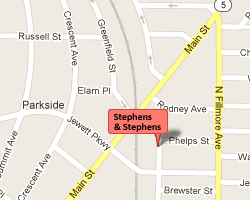Wolverine Tube Division
Home / Areas of Practice / Energy Employees Occupational Illness Compensation Program Act (EEOICPA) / EEOICP: Facility List / Wolverine Tube Division
Also Known As: Div. Of Calumet Hecia Consolidated Copper Co., Hermes Automotive, Mamif Corp.
State: Michigan
Location: Detroit
Time Period: BE 1943-1946; AWE 1943-1946; Residual Radiation 1947-1989
Facility Type: Atomic Weapons Employer, Beryllium Vendor
Facility Description
In 1943, the University of Chicago subcontracted to Wolverine Tube of Detroit, Michigan, for help in extrusion of metals that were needed as part of the Manhattan Project. Wolverine Tube performed research on the fabrication of aluminum slugs and the process of aluminum canning and also experimented with thorium and beryllium. This contract ended in 1946. Wolverine Tube received other AEC contracts because of its extrusion expertise.
During the period of residual contamination, as designated by the National Institute for Occupational Safety and Health and as noted in the dates above, employees of subsequent owners and operators of this facility are also covered under the Energy Employees Occupational Illness Compensation Program Act.
Listing
Wolverine Tube Division is listed as a Beryllium Vendor (BE) and as an Atomic Weapons Employer under the EEOICPA.
Compensation
As of 06/21/2015, the total compensation paid under Part B of the EEOICPA, including medical compensation, for workers suffering from the effects of having worked at Wolverine Tube Division is $452,100.
Wolverine Tube Division Workers
If you or your parent worked at this or any other AWE facility and became ill, you may be entitled to compensation of up to $150K plus medical benefits from the US Department of Labor. Call EEOICPA Counsel Hugh Stephens at 1-855-EEOICPA (336-4272) or fill out the form to the right, whether your claim has been accepted or denied.
We can help with all OWCP (Federal Workers Compensation) claims, impairments, wage loss and health care. 2495 Main Street, Suite 442 Buffalo, NY.
Site Function
During the period from June 1943, through January 1946, Wolverine Tube Division was under subcontract for services and supplies to the University of Chicago, Metallurgical Project, a MED contractor. Wolverine Tube, one of several machining subcontractors used by the University in the greater Chicago area, was awarded two subcontracts having maximum obligations of $40,000 and $6,000.
Under the terms of two subcontracts, Wolverine Tube Division furnished personnel and equipment, including its extrusion press and piercing mill, to develop methods and subsequently fabricate metallic tubing and sheaths. The metals worked probably included uranium, thorium, and beryllium. Wolverine Tube also provided personnel and facilities for the development of methods for spinning and welding the ends of aluminum cans. Some similar work may have been performed for the AEC after 1946.
Site Description
The Wolverine site was located at 1411 Central Avenue in Detroit, Michigan. This location is on the southwest corner of the intersection of Central Avenue and Pershing Avenue in the west-southwest section of downtown Detroit.
The site is comprised almost entirely by the concrete block building, which covers an area of about 30,000 m2 (330,000 ft2). The interior is mostly a series of bays defined by concrete block walls and steel support beams. There is a second story in the southeast corner of the building, which is otherwise single story. The current building is the one used for MED activities during 1943 to 1946.
Beryllium History and Status
As previously stated, beryllium metal was probably extruded at the Wolverine site. Chemical analysis for beryllium was made for six of the residue samples(Landis, 1990a) collected during the October 1989 survey. These represented dust, grime and paint. Low levels of beryllium were found ranging from 1.00 to 2.10 ppm. Although beryllium is listed by the Environmental Protection Agency as a hazardous substance (40 CFR Part 302), there are no guidelines for residual amounts of beryllium–from a chemical perspective. Therefore, the OSHA indoor air short-term exposure limit of 0.025 mg/m3, or 0.068 ppm, (Sax,1979) was used to evaluate the significance of the levels found in the residues.
A worst case scenario was postulated that somehow all the available dust becomes airborne within the building. Available dust with a concentration of 2 ppm was assumed to cover an area equal to the floor space of the building and 1 mm thick. The resulting concentration of beryllium in air in the building was 0.0007 ppm– with no credit for ventilation loses. This conservative estimate is well below the current 30-minute exposure limit of0.068 ppm, as well as a more conservative OSHA-proposed value of 0.005 ppm. This result confirms that the beryllium levels in the building are very low and pose no hazard to the building occupants.
*Source
Share this:
EEOICPA CLAIMS
If you or your parent worked any of the DOE or AWE facilities listed on this website and became ill, you may be entitled to compensation of up to $400K plus medical benefits from the US Department of Labor.
Call EEOICPA Counsel Hugh Stephens at 1-800-548-4494, email hstephens@stephensstephens.com, or fill out the form below whether or not you have already filed a claim and even if your claim has been accepted or denied.
Contact Us
"*" indicates required fields
*note: Submission of this form does not establish an attorney-client privilege.
Contact Us
Address:
2495 Main Street, Suite 442
Buffalo, New York 14214
Phone:
(716) 852-7590
Fax:
(716) 852-7599
After Hours:
(716) 208-3525
Email Us:
R. William Stephens, Esq.
R. Hugh Stephens, Esq.
Lisa P. Neff, Esq.

